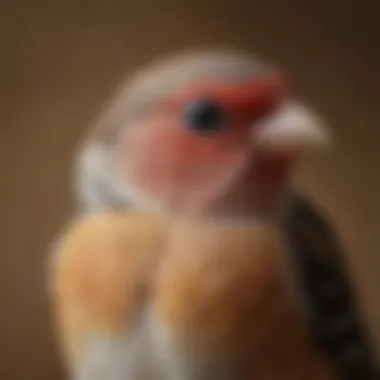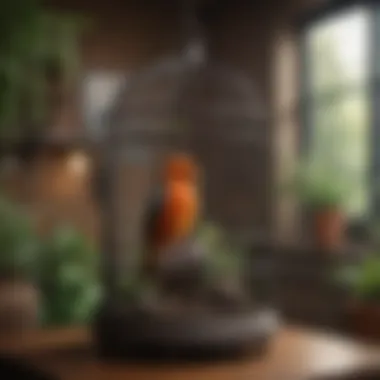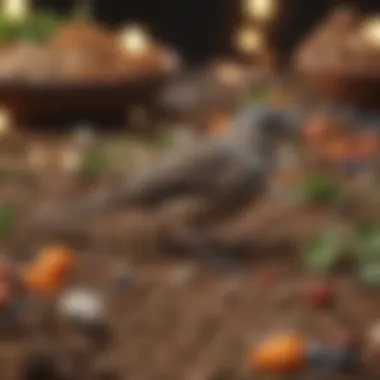Understanding Bird Lifespan: Key Insights for Pet Owners


Intro
Birds have captivated humans for centuries. They are not only beautiful creatures but also complex beings deserving of understanding and care. For pet owners, knowing the lifespan of various bird species is crucial. It informs their care choices and helps them plan for the long-term commitment that comes with bird ownership. This article aims to deliver an insightful exploration into avian longevity, focusing on the factors that influence a bird’s lifespan and what pet owners can do to enhance their pet’s quality of life.
Understanding Your Pet
Pet Behavior Basics
Understanding the behaviors of pet birds is essential for building a lasting bond. Birds communicate through various vocalizations and body language, signalling their feelings and needs. Recognizing these cues can help owners provide an environment where their pets feel safe and loved. Common behaviors include preening, singing, and engaging in social interactions. Ignoring these signals can lead to stress and health issues, illustrating the importance of attentiveness in pet care.
Common Breed Characteristics
Different bird species exhibit unique characteristics that impact their lifespan and care requirements. For instance, larger species like macaws tend to live longer, often reaching 50 years or more, while smaller ones, like finches, may only live up to 10 years. Each breed comes with its own set of personality traits and health predispositions, which is crucial for potential owners to consider when choosing a pet.
Species-Specific Needs
Ensuring that the pet bird's environmental needs are met is critical for its longevity. For example, species like cockatoos require social interaction and mental stimulation to thrive, whereas canaries are more solitary. Factors like cage size, ambient noise levels, and diet can significantly influence a bird's life expectancy. Owners should research the specific needs of their chosen species to provide an appropriate living environment.
Pet Care and Maintenance
Feeding Guidelines
Proper nutrition plays a vital role in boosting a bird's lifespan. Each species has specific dietary requirements, typically consisting of seeds, pellets, fruits, and vegetables. A balanced diet helps prevent obesity and related illnesses, significantly impacting their longevity. Consider investigating brands like Kaytee or Harrison's for high-quality bird food that meets these needs.
Grooming Essentials
Regular grooming is an often-neglected aspect of bird care that can affect their health. Beaks and nails need to be kept in check to avoid discomfort. Additionally, some birds also require periodic baths. A well-groomed bird will generally be happier and healthier, contributing to a longer life.
Hygiene Practices
Maintaining hygiene in a pet bird's environment is crucial. Cleaning the cage and replacing bedding frequently helps prevent bacterial growth and disease. Use safe cleaning solutions to ensure that the living space remains sanitized without harming your pet.
Training and Development
Basic Commands and Skills
Teaching a pet bird basic commands can enhance the owner-pet relationship. Simple cues like
Foreword to Bird Lifespan
Understanding the lifespan of birds takes on great significance for those who wish to own them as pets. The potential longevity of a bird can greatly influence the decision to bring one into a home. Different species exhibit varying life expectancies, and recognizing these differences is critical. This section sheds light on foundational aspects of bird lifespans, allowing pet owners to tailor care to enhance their birds' quality of life.
Defining Lifespan in Avian Species
Avian lifespan can be defined as the duration of life expected for birds within specific species. This figure varies widely, influenced by a combination of inherent biological factors and environmental conditions. For example, the average lifespan of a small parakeet touches around five to ten years, whereas larger species like macaws can live for fifty years or more. To grasp the concept of 'lifespan', it is important to differentiate between life expectancy in a controlled environment versus wild free-living conditions. Captive birds often experience extended lifespans due to consistent food supply, absence of predators, and focused care. Details like genetic predispositions also contribute to these metrics, engaging pet owners in understanding the avian species they choose.
Importance of Understanding Bird Lifespan
Comprehending the lifespan of pet birds goes beyond casual interest; it is a vital aspect of responsible pet ownership. Early understanding influences various activities, such as:
- Feeding Practices: Knowing a bird's lifespan helps to plan dietary strategies that align with its life stage.
- Investment Decisions: Longer living species require more long-term financial and emotional commitment.
- Planning for Care Needs: Different age ranges demand unique care considerations, from initial setup to advanced medical needs.


Additionally, awareness of potential lifespan fosters a connection between owners and their birds. When pet owners are informed, they are better equipped to create supportive environments and provide appropriate care. This not only benefits the individual bird but enriches the overall pet ownership experience.
Understanding your bird's lifespan is essential for a fulfilling companionship that can last many years.
Average Lifespan of Common Pet Birds
Understanding the average lifespan of common pet birds is crucial for any bird owner. This knowledge provides insight into what to expect regarding care and life stages of these animals. Lifespan varies significantly among species, which affects how owners should approach their pet's health and well-being.
Knowing how long a specific bird breed typically lives aids in planning for their long-term needs. For instance, more extensive care may be necessary for species with longer lifespans, such as cockatiels, compared to shorter-lived varieties. It also reinforces the idea that pet ownership involves a serious commitment, often lasting many years. By grasping the nuances of pet bird longevity, owners can make informed decisions that contribute positively to their pet's life.
Parakeets
Parakeets, also known as budgerigars, are popular as pets due to their friendly nature and vibrant colors. On average, a parakeet can live between 7 to 15 years with proper care. This range depends on multiple factors such as genetics, diet, and living conditions. Parakeets thrive in environments where they receive ample social interaction and mental stimulation. Moreover, they have a relatively easy time acclimating to life in a household, making them ideal companions for many families. A well-balanced diet of seeds, fruits, and vegetables plays a significant role in fostering their health and extending their lifespan. Regular vet visits also ensure they remain in good shape.
Cockatiels
Cockatiels are another favored pet bird known for their playful demeanor and engaging personalities. Generally, they have an average lifespan of 10 to 15 years. They require similar care as parakeets, but their specific needs slightly differ. Cockatiels need more room to exercise and are social creatures that benefit from interaction with their owners or companions. A diet high in fresh vegetables, coupled with quality pellets, is essential for maintaining their health. Mental stimulation, through toys and regular social time, heavily influences their quality of life and longevity. Cockatiels, when cared for properly, offer many years of companionship.
Canaries
Canaries, celebrated for their beautiful singing, range in lifespan from 10 to 15 years. Their life expectancy can be heavily influenced by diet, environment, and genetics. Because they are more solitary than some other pet birds, canaries may require less direct interaction than parakeets or cockatiels. However, they should still be provided with a stimulating environment and a balanced diet consisting of seeds, greens, and fruits. Their delicate constitution makes regular check-ups important, ensuring they remain healthy and vibrant. Proper care can allow canaries to thrive for over a decade, bringing joy through their song.
Budgerigars
Budgerigars, often referred to simply as budgies, typically boast a lifespan of 5 to 10 years in captivity. Despite being considerably shorter than that of cockatiels or canaries, budgerigars remain one of the most adored pet birds. Their vibrant plumage and friendly nature make them favorites among pet owners. Budgerigars require proper nutrition, social interaction, and mental stimulation to reach their maximum lifespan. Owners should be attentive to signs of stress or illness, providing them with a safe and comfortable habitat. With the right care, budgerigars can lead happy lives, enriching the home with their playful spirit.
Factors Affecting Bird Lifespan
Understanding the factors that affect a bird's lifespan is crucial for pet owners who want to ensure their avian friend lives a long, healthy life. A range of elements can contribute to longevity in birds, from genetic predispositions to the environments in which they live. Recognizing these factors allows pet owners to make informed decisions regarding the care and management of their birds.
Genetics and Species-Specific Traits
Genetics plays a significant role in determining the lifespan of avian species. Different species exhibit distinct traits that influence how long they live. For example, larger birds like macaws tend to have longer lifespans compared to smaller species such as finches.
Traits inherent in species also contribute to their health and vulnerability to conditions. Thus, when choosing a pet bird, consider not only the species but also any genetic predispositions. Breeding practices may lead to certain genetic health risks that can impact life expectancy. Researching the specific characteristics of the bird's lineage can provide insight into potential health concerns.
Dietary Influences on Longevity
A bird's diet directly impacts its overall health. Proper nutrition is fundamental for longevity. Birds require a balanced diet that includes seeds, fruits, vegetables, and grains. Each species has unique nutritional needs. For instance, cockatiels benefit from a mix of seeds and pellets, while parakeets may thrive with more fruit and greens.
Certain dietary deficiencies can lead to health problems that shorten lifespan. Regularly offering a varied diet rich in vitamins and minerals can prevent diseases and promote longer life. Likewise, avoiding unhealthy treats or over-reliance on seeds can contribute to a healthy avian diet.
Environmental Conditions
The environment where a bird lives significantly influences its lifespan. A clean and stimulating habitat is essential for well-being. Birds need adequate space for movement and to exercise. A cramped cage can lead to physical and mental health issues, reducing longevity. Additionally, exposure to toxins, such as cigarette smoke or strong cleaning agents, can poison birds over time.
Creating a suitable environment also encompasses mental stimulation through toys and social interaction. These elements enrich a bird's life and contribute to its overall health. Monitoring temperature, humidity, and light levels in the bird's living space can ensure they are comfortable and healthy.
Stress and Mental Well-Being
Stress can significantly affect a bird's health and lifespan. Birds are sensitive creatures, and various stressors can lead to behavioral changes and health issues. Common sources of stress include loud noises, frequent changes in their environment, and lack of companionship.
Providing a quiet, stable environment and regular interaction can help alleviate stress. Training birds and offering them challenges such as foraging activities can also keep them mentally stimulated. The emotional well-being of pet birds should not be overlook. A content bird is more likely to thrive and live longer.


Taking the time to understand and address these factors can enhance a bird owner's journey, fostering a happier and healthier companion.
By considering genetics, diet, environment, and stress, pet owners can tailor their care practices to promote longevity in their birds.
Common Myths About Bird Lifespan
Understanding the lifespan of pet birds requires dispelling common myths that often mislead pet owners. The objective is to create accurate expectations regarding the longevity of avian companions. Acknowledging these misconceptions helps ensure better care decisions and enhances the well-being of these animals.
Misconceptions about Lifespan Expectations
Many pet owners harbor unrealistic views about how long birds live. This often stems from anecdotal evidence or generalized beliefs. For instance, some think budgerigars live only a few years, ignoring the fact that they can have a lifespan of up to 10 years or longer when properly cared for.
It is essential to base lifespan expectations on reliable information rather than hearsay. Different species exhibit varying lifespans due to genetics and environmental factors. Owners should research their specific bird species to form realistic expectations.
Common Misbeliefs:
- All small birds have short lifespans: While some smaller birds may not live as long, many can have lifespans comparable to larger species.
- Longevity depends solely on species: Lifespan is influenced not only by species but by diet, care, and environment.
Awareness of these misconceptions empowers owners to provide better care, thus positively impacting their birds' lives.
The Role of Wild vs.
Captive Living Conditions The living conditions of birds significantly affect their lifespan. Some people assume that birds leading wild lives live shorter than those in captivity. However, this is not always the case.
Wild birds commonly face challenges such as predators, food scarcity, and diseases, which can limit their lifespans. Conversely, captive birds typically experience a more stable environment. With proper care, adequate nutrition, and veterinary attention, pet birds can live considerably longer.
However, captivity comes with its drawbacks. Birds that do not receive mental stimulation or social interaction may experience stress-related issues, affecting their overall health and longevity. Thus, while captive living can potentially promote longer lifespans, it is not a guarantee without adequate care.
Maintaining a balance between a safe environment and enriching activities is crucial. This understanding helps owners create conditions that support longevity.
“The decision to bring a bird into your home should consider the commitment to its welfare, including its lifespan.”
This narrative sheds light on myths surrounding bird lifespan, equipping pet owners with crucial insights. The understanding gathered here fosters responsible ownership, ensuring the right conditions for their avian companions.
Promoting Longevity in Pet Birds
Understanding how to promote longevity in pet birds is crucial for any owner who wishes to provide the best care possible for their avian companions. A bird's lifespan is influenced by several factors, including nutrition, habitat, regular veterinary care, and mental stimulation. By focusing on these key areas, pet owners can create an environment that supports the health and well-being of their birds, ultimately leading to a longer, healthier life.
Optimal Nutrition for Health and Longevity
Nutrition plays a foundational role in the longevity of pet birds. A well-balanced diet ensures that birds receive the necessary vitamins and minerals to maintain their health. This includes fresh fruits, vegetables, and high-quality pellets specific to their species. Avoiding excessive seeds, which can be high in fat and low in nutrients, is also important.
- Benefits of proper nutrition include:
- Enhanced immune function
- Better feather condition
- Higher energy levels and vitality
When it comes to feeding practices, offering a variety of foods prevents boredom and encourages exploratory behavior. This strategy not only aids in nutrition but also keeps the bird engaged and active.
Creating a Suitable Habitat
A suitable habitat is vital in promoting the longevity of pet birds. This entails providing a spacious cage that allows movement, as well as appropriate perches and toys that cater to their natural behaviors. Proper cage placement, ensuring minimal exposure to drafts or direct sunlight, is also an essential consideration.
- Key aspects of an ideal habitat include:


- Regular cleaning to prevent the development of mold or bacteria
- Secure nesting areas for rest and tranquility
- Opportunities for climbing and exploration
By mimicking their natural surroundings, pet owners can create an environment that supports their birds’ physical and mental well-being.
Regular Veterinary Check-Ups
Regular veterinary visits are crucial for maintaining a bird’s health over its lifespan. An avian vet can monitor for potential health issues early on, offering recommendations for preventive care. These check-ups typically include:
- Physical exams to assess general health
- Blood tests to screen for diseases
- Recommendations for vaccines or other necessary treatments
Keeping accurate records of visits and treatments ensures that a bird receives personalized care tailored to its unique needs.
Mental Stimulation and Social Interaction
Mental stimulation is equally important for the longevity of pet birds. Birds are social creatures who thrive on interaction and engagement. Providing toys that challenge their problem-solving skills or introducing training sessions can promote cognitive health. Birds that experience consistent social interaction tend to lead happier, more fulfilling lives.
- Ways to enhance mental stimulation include:
- Rotating toys to keep their environment fresh
- Engaging with them through verbal communication
- Allowing supervised time outside their cage to explore
Through these practices, increased mental fitness can lead to reduced stress levels in birds, contributing to their overall well-being.
Taking care of a bird involves understanding its natural needs and creating an atmosphere that fosters health and happiness. By promoting longevity through proper nutrition, suitable habitats, regular vet visits, and social interaction, pet owners can enhance the life of their feathered friends.
Understanding End-of-Life Care for Birds
Providing proper end-of-life care for your avian companion is crucial as it directly influences their quality of life during their later years. By understanding what to expect as your bird ages, you can better support their needs. This section aims to highlight the significance of recognizing aging indicators and making informed care decisions that contribute to a compassionate approach for tailored care.
Recognizing Signs of Aging
Birds, like all living creatures, experience changes as they age. Recognizing signs of aging can help you adapt your care to meet their specific needs. Here are some common indicators that can signify your bird is entering this stage of life:
- Behavioral Changes: You may observe a decrease in activity levels. Your bird might stay perched more often or become less interested in their toys or social interaction.
- Physical Mobility: Aging birds may show signs of stiffness or difficulty in flying. They may hop or walk instead of taking flight, indicating potential arthritis or other mobility issues.
- Feather Quality: Changes in feather health are typical. You may begin to notice more broken feathers or a decline in vibrancy, reflecting potential nutritional deficiencies or health concerns.
- Weight Fluctuations: Monitor your bird's weight regularly. Unexplained weight gain or loss can indicate underlying health conditions that may need addressing.
Important Note: Keeping a watchful eye on your bird's habits and physical condition contributes significantly to their overall well-being as they grow older.
Making Informed Decisions Regarding Care
When it comes to the care of aging birds, informed decision-making is essential. As pet owners, your choices can greatly affect the comfort and dignity of your bird's remaining time. Consider these key factors:
- Veterinary Guidance: Regular check-ups become even more pertinent as your bird ages. Your veterinarian can offer health screenings, suggest appropriate diagnostics, and screen for age-related diseases.
- Diet Adjustments: Aging birds may require dietary changes. Consult with a vet about the best nutritional options suited for senior birds, as their needs differ from younger counterparts.
- Comfort and Environment: Providing a safe and comfortable habitat becomes critical. Ensure that your bird has access to easy perches, cozy hiding spots, and opportunities for gentle stimulation.
- End-of-Life Discussions: Prepare yourself for difficult yet necessary conversations regarding potential euthanasia or palliative care. Understanding when to let go is part of responsible pet ownership.
By embracing these aspects, you create a supportive environment that respects the dignity of your aging bird. Throughout this process, it is important to remain attentive and adaptable. Your love and care can greatly enhance their quality of life, even in their final stages.
Finale: Insights on Bird Longevity
Understanding the intricacies of bird longevity is paramount for pet owners. This conclusion synthesizes the essential information discussed in this article and brings to light several key elements crucial for the well-being of pet birds. By grasping the significance of lifespan knowledge, one can provide a nurturing environment that enhances both the quality and duration of a bird's life.
Summary of Key Points
- Average Lifespan: Familiarizing oneself with the typical life expectancy of various pet bird species sets realistic expectations. For example, parakeets may live 5 to 10 years, whereas cockatiels can reach 15 years or more.
- Influential Factors: Multiple elements influence a bird's lifespan, such as genetics, diet, environmental conditions, and mental well-being. Ensuring a balanced diet and reducing stress can greatly affect longevity.
- Myths Busted: Recognizing common misconceptions about avian life spans is essential. Understanding that captive birds can live longer than their wild counterparts, given the right care, is vital for responsible ownership.
- End-of-Life Care: Addressing the aging process and recognizing signs of diminished health are critical steps for pet owners. This ensures that informed decisions can be made regarding a bird's care as it nears the end of its life.
- Promoting Longevity: Creating an enriching environment that includes proper habitat, nutrition, and social interaction plays a significant role in extending a bird's lifespan. Regular veterinary visits further support health and longevity.
Future Considerations for Bird Owners
As society progresses, so does the understanding of animal care, including that of birds. Future pet owners should keep the following considerations in mind:
- Education and Awareness: Continuous learning about avian species and their respective needs will empower owners. Books, online forums, and communities, such as those found on Reddit and Facebook, can be invaluable resources.
- Personalized Care: Each bird is an individual with unique needs. Tailoring care to specific species and personal traits can lead to enhanced well-being and longevity.
- Research Developments: Staying updated on the latest research in avian health practices could provide new insights into optimal care and preventive measures. This can include advancements in dietary needs or habitat requirements to better suit their lives.
- Community Support: Engaging with other bird owners can provide support and shared knowledge experiences. Collaborating helps create a culture of responsible ownership, where discussions about best practices are prevalent.
Ultimately, understanding bird longevity is an integral aspect of responsible pet ownership. Making informed decisions based on thorough knowledge can lead to a fulfilling relationship between pet birds and their owners. This knowledge base helps not only in enjoying a prosperous life with your feathered friend but also in ensuring their overall health and happiness.







